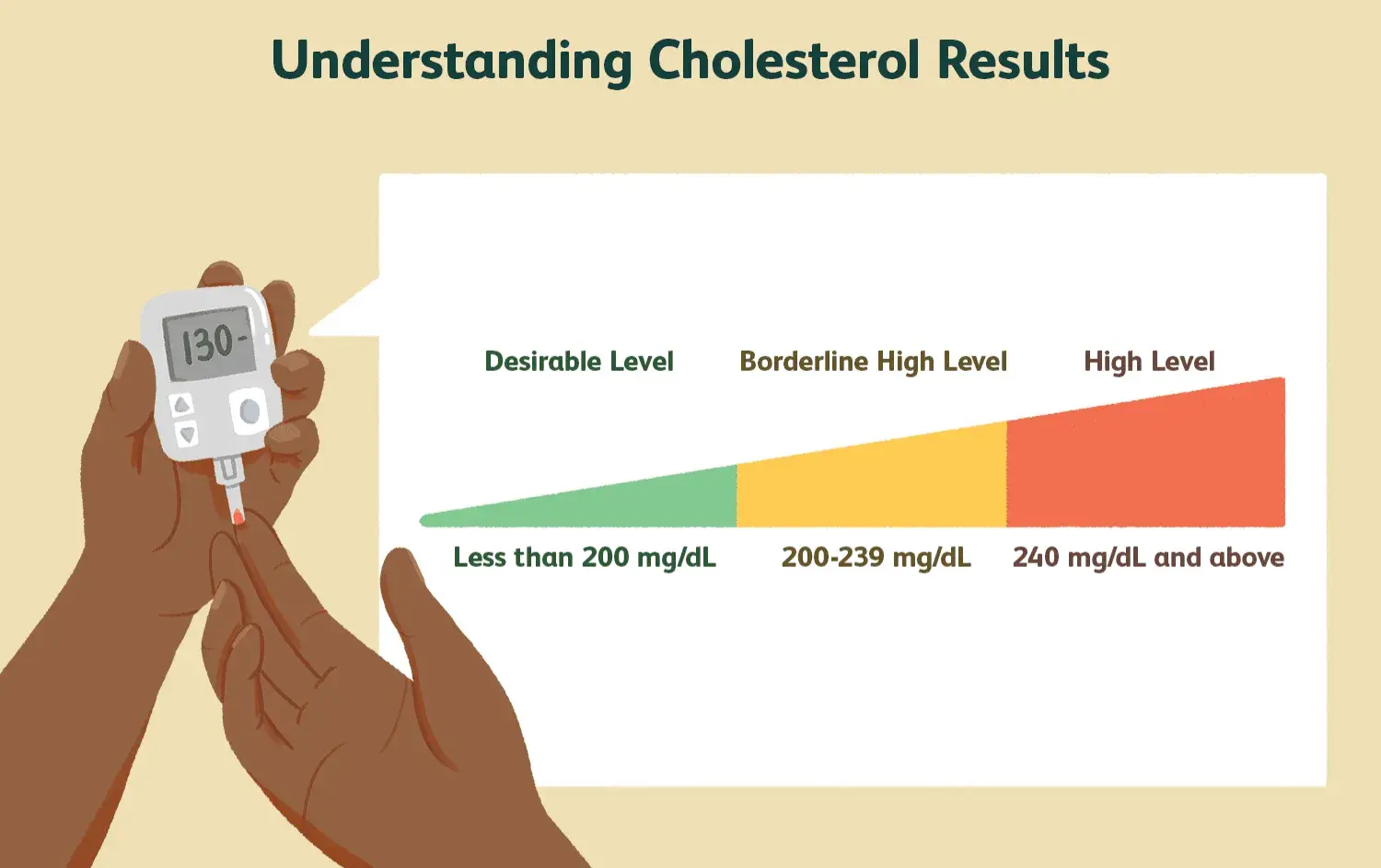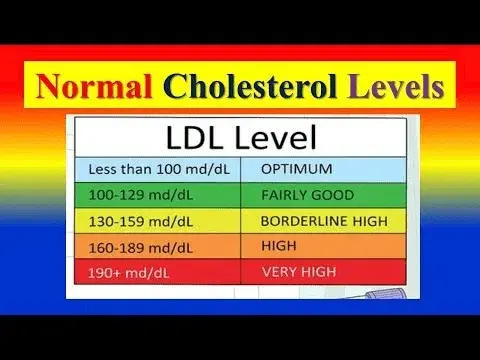Total cholesterol is a measure of the cholesterol levels in your blood. Your liver is the organ responsible for the production of cholesterol, a waxy, fat-like molecule that is also present in some foods. It is necessary to properly function your cells, but high blood cholesterol levels can increase your risk of heart disease and stroke. Total cholesterol is a combination of low-density lipoprotein (LDL), high-density lipoprotein (HDL), and a small number of triglycerides, fat found in your blood. LDL cholesterol range is often called "bad" cholesterol because it can contribute to plaque buildup in your arteries, increasing your risk of heart disease. On the other hand, HDL cholesterol normal range is often referred to as "good" cholesterol because it helps to remove excess cholesterol from your body and protect against heart disease. Furthermore, in this blog you will understand what is the normal range for cholesterol levels?
How Is Cholesterol Level Determined?
 To determine your cholesterol levels normal range, your doctor administers a blood examination called a lipid panel (or lipid profile). Your doctor will draw blood from a vein in your arm and send it to a laboratory for analysis. Make sure you strictly follow the exam preparation instructions offered by your supplier. You'll likely need to fast for 12 hours first. This necessitates avoiding all food and beverages other than water.
To determine your cholesterol levels normal range, your doctor administers a blood examination called a lipid panel (or lipid profile). Your doctor will draw blood from a vein in your arm and send it to a laboratory for analysis. Make sure you strictly follow the exam preparation instructions offered by your supplier. You'll likely need to fast for 12 hours first. This necessitates avoiding all food and beverages other than water.
Total cholesterol normal range level of 200 mg/dL or greater are often considered high. However, your healthcare providers further categorize it into "borderline high" and "near ideal" categories. If your values are close to normal ranges, making dietary and lifestyle adjustments may make them simpler to control.
The Normal Range For Cholesterol
Less than 200 mg/dL of total cholesterol is considered normal. However, your healthcare provider will consider your age, gender, and other risk factors when determining your healthy cholesterol level. If your total cholesterol is high, your healthcare provider may recommend lifestyle changes, such as eating a healthy diet and exercising regularly and may prescribe medications to help lower your cholesterol levels.
Normal Cholesterol Level Chart
| Age/sex | Total cholesterol levels |
| Male or female below age of 19 | Less than 170 mg/dL |
| male, aged 20 or more | 125 to 200 mg/dL |
| female, aged 20 or more | 125 to 200 mg/dL |
This is the normal cholesterol chart. Your healthcare provider will inform you when your findings are ready. Your electronic medical records will also allow you to access your results.
Read Also: 6 Best Ways to Lower Your Cholesterol Level Without Medication
You will receive the following numbers from your lipid panel normal range:
1. Normal range for total cholesterol
This represents all of the cholesterol in your blood. The formula for calculating it is as follows: Total cholesterol is equal to HDL plus LDL plus 20% triglycerides.
2. HDL cholesterol normal range
High-density lipoprotein is called HDL. This "good" cholesterol transports extra cholesterol to your liver. Your liver then excretes it from your system. Consider the letter "h" to be helpful when you see HDL. HDLs rid your arteries of the cholesterol your body doesn't require. You want this particular lipid panel number to be high.
3. LDL cholesterol normal range

Low-density lipoprotein is called LDL. This "bad" cholesterol increases the likelihood of plaque buildup in your arteries. Because they deliver cholesterol to your body's cells, ldl cholesterol normal range are essential. However, having too many can lead to issues.
4. VLDL cholesterol normal range
Very low-density lipoprotein is the term used. Another "poor" type that aids in plaque development is this one.VLDLs are a type of fat that goes through your bloodstream. Too many VLDLs can cause excess fat to accumulate in your arteries.
5. Triglycerides
This kind of fat is required by the body. But having high amounts (hypertriglyceridemia) can make you more susceptible to problems like atherosclerosis.
6. Non-HDL Cholesterol
Any cholesterol in your blood that isn't HDL is represented by this. This figure can be calculated using the formula: non-Hdl cholesterol normal range equals total cholesterol minus HDL. The ratio of total cholesterol to HDL is the result of dividing your total cholesterol by HDL. Ideally, you want your number to be less than five. Your results can include a chart with further information and acceptable levels. With milligrams of cholesterol per deciliter of blood, cholesterol levels are measured by medical professionals. Mg/dL is the abbreviation. Providers measure your triglyceride levels using the same units.
Also Read: What do 'Cholesterol Levels' mean?
How frequently should your cholesterol levels be tested?
Cholesterol levels should be tested based on various factors, including age, sex, family history, and other risk factors: For people who are 19 or younger than that, the first test must be done sometime between the age of 9 to 11. If family history poses a risk of high cholesterol, blood pressure, and cardiac issues, the test should be done as early as the age of 2 years. People who are aged 20 or more should get a test done every 5 years, and after attaining the age of 45, you should increase the frequency to 1 to 2 years.
Also Read: 13 ways to lower blood pressure instantly in an emergency
Final Takeaway
Total cholesterol is a measure of the cholesterol in your blood. It measures all the different cholesterol and fats in your blood, including low-density lipoprotein (LDL), high-density lipoprotein (HDL), and triglycerides. Healthy cholesterol levels occur when the result is in a range of less than 200 mg/dL.
A high total cholesterol level (more than 240 mg/dL) is a risk factor for heart disease. It is important to check your cholesterol regularly and work with your healthcare provider to manage your average cholesterol levels if they are too high. This may include making lifestyle changes such as eating a healthy diet, exercising regularly, not smoking, and taking medications if necessary.
Also Read: 10 Foods That Lower Cholesterol Naturally
If you struggling for the right treatment, visit Best Cardiologist in Pune.
Frequently Asked Questions
What is a healthy cholesterol level?
Typically, Doctors recommend a healthy cholesterol level as having a total cholesterol level below 200 milligrams per deciliter (mg/dL), with low-density lipoprotein (LDL) cholesterol below 100 mg/dL and high-density lipoprotein (HDL) cholesterol above 40 mg/dL for men and above 50 mg/dL for women.
What are LDL cholesterol levels?
LDL cholesterol levels indicate the amount of "bad" cholesterol in your blood, with a healthy level typically below 100 mg/dL.
What is normal cholesterol level?
A normal cholesterol level is typically considered to be below 200 milligrams per deciliter (mg/dL), but optimal ranges may vary based on individual health factors.
What is lipid profile test?
A lipid profile test is a blood test that measures levels of cholesterol, triglycerides, and lipoproteins, providing insights into cardiovascular health.
What is a good cholesterol level?
A good cholesterol level is generally considered to be above 40 mg/dL for low-density lipoprotein (LDL) and above 50 mg/dL for high-density lipoprotein (HDL).
Reviewed by







